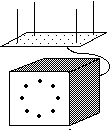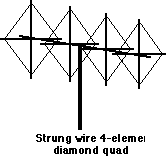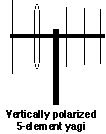Dopplers Have Their Place
An ideal RDF system would not require constant manual antenna turning. It
would take directional readings hundreds of times per second, and continue to
indicate the bearing after the signal leaves the air. Doppler type RDF sets,
though far from ideal, fulfill all these wishes. The typical four-whip antenna
system can be mounted without drilling holes in the vehicle.
 Doppler readouts typically feature a ring of at least 16 LEDs, and may also
include a three-digit display in degrees relative to the vehicle. In the
clear, a well-installed doppler has about +/-5 degree bearing accuracy. This accuracy is degraded by multipath, just like it is with the homing RDF, but
"eyeball averaging" while the vehicle is moving helps counteract this
problem.
Doppler readouts typically feature a ring of at least 16 LEDs, and may also
include a three-digit display in degrees relative to the vehicle. In the
clear, a well-installed doppler has about +/-5 degree bearing accuracy. This accuracy is degraded by multipath, just like it is with the homing RDF, but
"eyeball averaging" while the vehicle is moving helps counteract this
problem.
Although popular in many places, doppler RDF installations have
not caught on among most southern California competitive T-hunters due to their
lower sensitivity compared to beam setups. Vertically polarized
doppler antennas are at an extreme disadvantage if the hider transmits
horizontal polarization, especially if the hider's signal is weak and non-direct, as it often is here.
On the other hand, dopplers are a popular choice of jammer hunters, who are
usually tracking strong vertically polarized signals. They like the rapid
indication update rate and the ability to quickly get bearings on
short-duration signals. Occasionally, you may see RDFers using both a beam
and a doppler set on the same vehicle.
How To Learn More
While commercial RDF equipment is available, the majority of southern
California T-hunters prefer to build their own gear. All you need to get
started is a directional antenna, an attenuator to knock down strong nearby
signals, and a receiver with S-meter. You may have it all right now! If so,
it will only take a bit of installation work on the family car to get you
going.
For equipment information, installation ideas, and hunting techniques, read
TRANSMITTER HUNTING---Radio Direction Finding Simplified by KØOV and WB6UZZ,
published by Tab Books (#2701). This book is available at some electronics and
ham radio stores. It is also available by mail from the authors.
Have a new ham radio adventure by going out on a hidden transmitter hunt. Be
prepared for some pleasant surprises. Remember, every time you set out on a
hunt, you never know where you'll end up, and you never know what you will
find.
Above article Copyright ©1992 and 2009 by Joseph D. Moell. This article (and only this article on the site) may be reproduced in club newsletters and other non-commercial publications, provided that it is printed in its entirety (either with or without illustrations) and readers are encouraged to visit this Homing In Web site: http://www.homingin.com
If you reprint this article, please send a copy of it via e-mail or by postal mail to: Joe Moell KØOV, PO Box 2508, Fullerton, CA 92837
 Surfing suggestions: Read "T-Hunting Then and Now -- From Gooney Birds to GPS" for stories of some classic southern California transmitter hunts from years past.
Surfing suggestions: Read "T-Hunting Then and Now -- From Gooney Birds to GPS" for stories of some classic southern California transmitter hunts from years past.
 Go to Southern California T-hunts for Beginners page
Go to Southern California T-hunts for Beginners page
Back to the Homing In home page
This page updated 23 July 2025
 Transmitter hunting seems to be one of the best kept secrets in ham radio, even
though dozens of hams here consider themselves to be regular hunters. They
range in age from the teens to the eighties. Besides keeping the coordinated two-meter hunt frequency (146.565 MHz FM) hopping, some hunters
love to hash over their exploits by the hour on their favorite repeaters.
Transmitter hunting seems to be one of the best kept secrets in ham radio, even
though dozens of hams here consider themselves to be regular hunters. They
range in age from the teens to the eighties. Besides keeping the coordinated two-meter hunt frequency (146.565 MHz FM) hopping, some hunters
love to hash over their exploits by the hour on their favorite repeaters. In the Los Angeles basin, most hunters use some sort of beam antenna. Three to
five element cubical quads are most popular. Usually they are built in "diamond" form
with a PVC pipe or wood boom and elements made of thin wire strung on
fiberglass spreaders. Variations include the "stiff wire" version, which is
much more tree-resistant. (It can get mashed, but is easily re-shaped and
returned to service, as compared to "strung-wire" quads which more readily suffer
wire breakage.)
In the Los Angeles basin, most hunters use some sort of beam antenna. Three to
five element cubical quads are most popular. Usually they are built in "diamond" form
with a PVC pipe or wood boom and elements made of thin wire strung on
fiberglass spreaders. Variations include the "stiff wire" version, which is
much more tree-resistant. (It can get mashed, but is easily re-shaped and
returned to service, as compared to "strung-wire" quads which more readily suffer
wire breakage.) No matter which gain antenna is used, it is important that to
allow for quickly changing polarization. Hiders can use any wave polarization on
most hunts, so hunters must attempt to determine the correct polarization and
hunt with it. Hunting a horizontal signal with a vertically polarized beam,
for example, causes the direct signal to be attenuated. Reflections and
scattered signals (multipath) from buildings and terrain features are enhanced
relative to the direct signal when the wrong polarization is chosen. There are mechanical and
No matter which gain antenna is used, it is important that to
allow for quickly changing polarization. Hiders can use any wave polarization on
most hunts, so hunters must attempt to determine the correct polarization and
hunt with it. Hunting a horizontal signal with a vertically polarized beam,
for example, causes the direct signal to be attenuated. Reflections and
scattered signals (multipath) from buildings and terrain features are enhanced
relative to the direct signal when the wrong polarization is chosen. There are mechanical and  Another type of RDF instrument, called the homing or dual-antenna RDF, has its
place in the arsenal of the well-equipped hunter. These units have a pair of
vertical antennas, a switching circuit, and a direction sensor with some
sort of left-right indicator, such as a meter or a pair of LEDs. They are easy
to use: When the indicator says LEFT, turn the unit left; when it indicates
RIGHT, turn right. There is a sharply defined crossover at which the unit points
toward the signal source direction.
Another type of RDF instrument, called the homing or dual-antenna RDF, has its
place in the arsenal of the well-equipped hunter. These units have a pair of
vertical antennas, a switching circuit, and a direction sensor with some
sort of left-right indicator, such as a meter or a pair of LEDs. They are easy
to use: When the indicator says LEFT, turn the unit left; when it indicates
RIGHT, turn right. There is a sharply defined crossover at which the unit points
toward the signal source direction.  Doppler readouts typically feature a ring of at least 16 LEDs, and may also
include a three-digit display in degrees relative to the vehicle. In the
clear, a well-installed doppler has about +/-5 degree bearing accuracy. This accuracy is degraded by multipath, just like it is with the homing RDF, but
"eyeball averaging" while the vehicle is moving helps counteract this
problem.
Doppler readouts typically feature a ring of at least 16 LEDs, and may also
include a three-digit display in degrees relative to the vehicle. In the
clear, a well-installed doppler has about +/-5 degree bearing accuracy. This accuracy is degraded by multipath, just like it is with the homing RDF, but
"eyeball averaging" while the vehicle is moving helps counteract this
problem.
